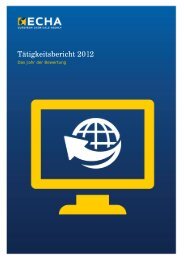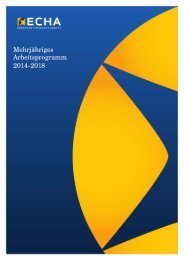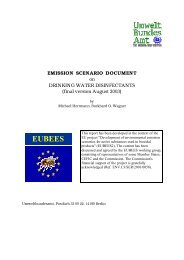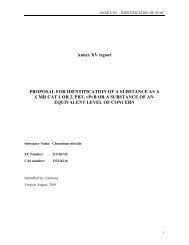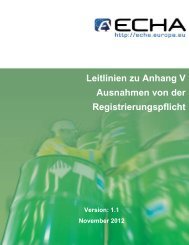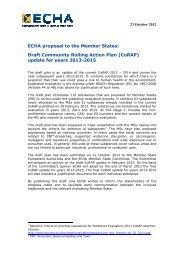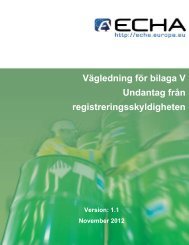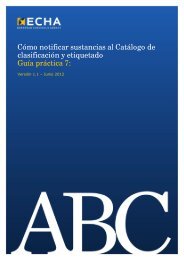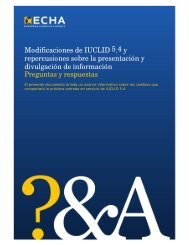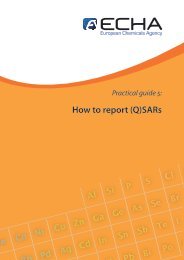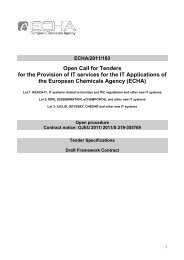Strategy For Limiting Risks Human Health Draft of ... - ECHA - Europa
Strategy For Limiting Risks Human Health Draft of ... - ECHA - Europa
Strategy For Limiting Risks Human Health Draft of ... - ECHA - Europa
Create successful ePaper yourself
Turn your PDF publications into a flip-book with our unique Google optimized e-Paper software.
Comparison <strong>of</strong> MOS and reference MOS<br />
The different scenario- and endpoint-specific MOS values are compared with the respective<br />
reference MOS. MOS values clearly above the reference MOS do not lead to concern,<br />
whereas MOS values that are clearly below the reference MOS give reason for concern. There<br />
are also risk-related aspects which cannot be covered quantitatively by assessment factors.<br />
These additional aspects are considered qualitatively when performing the risk assessment<br />
and have adequate influence on the finding <strong>of</strong> the conclusions. Especially in case <strong>of</strong><br />
borderline scenarios these aspects might be decisive.<br />
Critical Exposure Levels<br />
In a parallel procedure, which gives identical but more direct results, the adjusted<br />
toxicological starting point is directly divided by the reference MOS. As a result, an exposure<br />
level (in mg/m³ or mg/kg/d) is identified, which may serve as a direct trigger for decisions<br />
when compared with the occupational exposure levels. In the context <strong>of</strong> this risk assessment<br />
report this trigger value is called “critical exposure level”. Concern will be expressed for<br />
scenarios with occupational exposure levels higher than the relevant “critical exposure level”.<br />
Acute toxicity<br />
From acute inhalation studies in animals with cryolite dust there is indication for severe local<br />
effects in the respiratory tract, leading to mortality at high air concentrations. These effects<br />
have been evaluated in the RAR-chapter 4.1.3.2.3, irritation and corrosivity, in combination<br />
with the results <strong>of</strong> the short-term inhalation studies. These also give evidence <strong>of</strong> significant<br />
local irritation properties <strong>of</strong> cryolite and allow for a quantitative analysis. <strong>For</strong> the evaluation<br />
<strong>of</strong> acute toxicity in this chapter the local effects in the acute inhalation study therefore are not<br />
used.<br />
From the oral and the dermal application route there is no indication for adverse systemic<br />
effects <strong>of</strong> cryolite after short-term exposure up to limit doses. In a guideline-compliant rat<br />
inhalation study, a LC50 <strong>of</strong> 4,470 mg/m 3 was derived. No mortality and no clinical sings were<br />
observed at 1,330 mg/m 3 . The highest occupational exposure value is described in scenario 3<br />
with 10 mg/m 3 . Compared to the value <strong>of</strong> 1,330 mg/m 3 , where no severe effects are described,<br />
the margin <strong>of</strong> safety is judged to be sufficient. This is confirmed by data from workers with<br />
high exposure to cryolite and by the different long-term studies, which did not give evidence<br />
<strong>of</strong> acute symptoms except those <strong>of</strong> local irritation.<br />
In summary there is no indication that significant systemic effects might be caused by shortterm<br />
exposure to cryolite at the workplace, there is no concern for workers from this aspect.<br />
Irritation and corrosivity<br />
15<br />
Conclusion: ii<br />
Skin<br />
There is no standard skin irritation test available. In a well-conducted skin sensitisation study<br />
(GPMT) no dermal reactions at all have been obtained. From literature data cryolite is said to<br />
be not irritating to skin. There are no reports on skin effects from the different studies on<br />
workers. In summary there is no concern for dermal irritation at the workplace.



